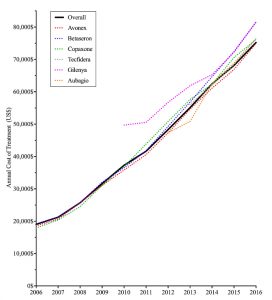Another Study Shows That Costs of Disease-modifying Therapies Are Zooming

It probably comes as no surprise to you that the costs of some of the most popular MS medications have been soaring. A new study by researchers at the University of Pittsburgh reports that their list prices have more than quadrupled in a decade. And out-of-pocket costs rose even more.
The researchers studied the costs of self-administered disease-modifying therapies (DMTs) using Medicare claims data from 2006 through 2016. Their findings, published in the journal JAMA Neurology, show that the average list price for those meds rose from $18,660 in 2006 to $75,847 in 2016.
Those costs get passed down to patients. According to the university’s news release, “from 2006-2016, Medicare spending increased by more than tenfold, and the patients themselves saw more than a sevenfold increase in their share of the bill.”
The prices of Avonex (interferon beta-1a), Betaseron (interferon beta-1b), Copaxone (glatiramer acetate), Tecfidera (dimethyl fumarate), Gilenya (fingolimod), and Aubagio (teriflunomide) rose side by side, as shown in the following chart:

(Courtesy of University of Pittsburgh Medical Center)
“One of the most significant findings was that the prices of these drugs have increased in parallel,” said Alvaro San-Juan-Rodriguez, a doctor of pharmacy and the study’s lead author. “Only a couple exceptions deviate from that general trend.”
San-Juan-Rodriguez told Business Insider he’s surprised at the size of the price hikes. “We were not expecting the magnitude of the drug price increase at all,” he said. “The price is exorbitant, and it’s higher than what we’ve seen for other specialty drug medications.”
What can we do about this?
At the beginning of the year, I wrote about a similar study from Oregon Health and Science University. It reported that Medicare spent $1.8 billion in 2013 to provide DMTs to people with MS — one of the largest amounts paid for any disease medication. MS patients spent an average of $4,389 out of pocket in that year. Only hepatitis patients spent more. That falls in line with the University of Pittsburgh study.
I call the cost of our MS medications the “elephant in the examining room.” Call me a pessimist, but despite all the noise made by U.S. politicians of both parties about the need to reduce the cost of medications, I don’t think things will be getting better anytime soon.
So, it’s important that we, as people with MS, make sure to have a discussion about treatment costs with our neurologists each time they prescribe one. A balance is needed between our treatment goals and our ability to afford our medications. After all, what good is a med if we have to skip doses, as some people do, in order to pay for it?
Let’s also keep our lawmakers’ feet to the fire on medication price reforms, even if any results could be a long time coming.
You’re invited to visit my personal blog at www.themswire.com.
***
Note: Multiple Sclerosis News Today is strictly a news and information website about the disease. It does not provide medical advice, diagnosis, or treatment. This content is not intended to be a substitute for professional medical advice, diagnosis, or treatment. Always seek the advice of your physician or other qualified health provider with any questions you may have regarding a medical condition. Never disregard professional medical advice or delay in seeking it because of something you have read on this website. The opinions expressed in this column are not those of Multiple Sclerosis News Today or its parent company, Bionews Services, and are intended to spark discussion about issues pertaining to multiple sclerosis.







Charles Dick
two years of my medication would cost more than my house and college student loans combined. the reason is the interplay between private insurance and pharmaceutical companies. they keep ratcheting up prices because everyone wants a profit. we need a robust single payer healthcare system like Medicare For All. any candidate who does not support that does not deserve the support of the people.
W
I would also like to see a realistic re-evaluation of Avonex. Avonex has a low (in general) efficacy status, and yet is a demanding treatment that poses risks ranging from necrosis to liver damage. With a sky-high price tag, why aren't researchers at Biogen able to offer a med that does not make most patients feel as if they have (sometimes horrible) cases of influenza? Or that does not require an intramuscular injection -- it's a very long needle.
It does not even seem as if Avonex should have been approved in the first place. Decades have passed! It's discouraging that this iffy med is still a standard treatment.
Ed Tobias
W -
I was in the Phase III clinical trial for Avonex and was one of the first people to use it after it received FDA approval. I believe it helped slow the progression of my MS. While I didn't get any of the flu-like side-effects I hated that injection and, after a couple of years, I moved to Tysabri. Incidentally, it's also made by Biogen. Avonex was the best there was back then but, as you note, it's now one of the least effective of the DMTs.
While many old school neuros still prescribe Avonex and other 20 year old meds, there are currently 17 DMTs approved for use in the U.S. Neuros who are of the new school are more likely to start off prescribing a DMT with much higher efficacy than Avonex or the other older treatments. I agree with their philosophy.
Ed
W
Ed -
Thanks for your response. It's good that you did not get the Avonex "flu." (I have read that Avonex in the pre-filled syringes unfortunately tends to give patients more side effects . . . the meds used to need to be mixed). How interesting that you trialed Avonex.
It is difficult to say (at least in my case) what Avonex has or has not done. (We also need better ways to somehow measure efficacy.)
My problem with the newer pills and infusions is their heavier risk burden. For example, Ty has a PML risk and also an occasional bad bounce back when patients stop using it. I know that these concerns have some solutions (for example, getting tested for the JC virus). But it is hard to take on more and more risks (not that Avonex doesn't pose risks of its own).
Ed Tobias
Yes, a benefits vs risks analysis needs to be made by everyone who is considering a DMT. Following Avonex I went to Tysabri and, even though I'm JCV+ I considered the PML risk minimal. That's because I was carefully monitored with an MRI and bloodwork every six months and I have a neurologist in whom I have great trust. After two years on that med she moved me from monthly infusions to every eight weeks to limit the risk. That bought me additional time and I was able to use Tysabri for a little over 7 years. I then moved to Aubagio and, finally, to Lemtrada. Now, at 71 years old and nearly 18 months past my second Lem around, I feel I've been treated with my final DMT.
My neuro-patient relationship was key in feeling comfortable with all of my treatment decisions. It's really needs to be a collaboration and I'm very fortunate to have had the same great neuro for over 15 years. (And, to have had good insurance).
We absolutely need a better way of measuring efficacy. Studies, traditionally, have based efficacy on the EDSS test, which only measures mobility. There's so much more to look at. Head-to-head comparisons of multiple DMTs are also lacking.
So, we do what we can.
Ed
W
The additional information about your course of MS medications is very interesting.
As a senior myself, I am truly hoping that better methods of measuring efficacy will be in place soon to help younger patients make the best possible decisions, albeit MS is (like life in general) unpredictable.
Thank you for this great web site.
Patricia Mazzella
Pharmaceutical companies are billion dollar industries. Several of the leading MS DMDs are manufactured and patented by one company. Why should we as patients have a “conversation” with our neurologist about more affordable drugs with less efficacy? Does a diabetic ask their provider to partially treat their disease? Does a hypertensive patient ask to be prescribed a lower priced drug is ineffective in lowering their elevated blood pressure? It is the patient that suffers irreversible damage and long-term disabilities from the rising costs in pharmaceutical prices. This is negligent healthcare for MS patients.
Ed Tobias
Hi Patricia,
Thanks for your comments.
You're right, we deserve the most effective medications that can be prescribed. And our medications should be affordable. But in the world we live in today the reality is our meds aren't affordable. Until that changes, if it ever does, neuros need to take that into account and work with their patients to find a treatment will help but will also be used.
Ed
Patricia Mazzella
I didn’t ask to have this disease. I have been diligent and compliant in taking my prescribed medication and following my neurologist’s plan of care. I am currently enrolled in the Biogen Patient Assistance Program. I even participated in a patient home injection training program, where I drove to patient homes and instructed them on proper self-injection techniques and side-effects. I am an RN with an MSN in Nursing Education. I am no longer able to work as an RN, but I have repeatedly been denied disability although I have 33 lesions.
anon
I have been denied disability, too, despite having 20+ lesions. We truly need new ways to evaluate MS disabilities. Patients are told that they have a serious, progressive, life-long disease (all true), and yet disability evaluators cannot help them as the guidelines simply don't fit a sometimes "invisible" illness.
Brenda Robbins
The costs of DMT's being on the rise is a no brainer. Why any studies were done is beyond me. It is a total waste of money. Those of us taking these therapies could have told who ever is looking at these charts to report back to us could have just asked us!!! I am 62. The costs at Medicare time without the help from the pharma company frightens me. I don't believe what I will have to pay is something I can do. Right now, with insurance I can handle my costs. In 3 years I don't believe I will be able to continue.
Ed Tobias
I agree, Brenda. Ask and we'll tell about costs.
When I moved from commercial insurance to Medicare I had to switch from an oral med (Aubagio), which was covered under Part D, to Lemtrada. Because Lemtrada is an infusion it's covered under Part B and Medicare pays for 80%. My secondary insurance picks up the other 20%. That may be the way for you to go when you reach 65.
Ed